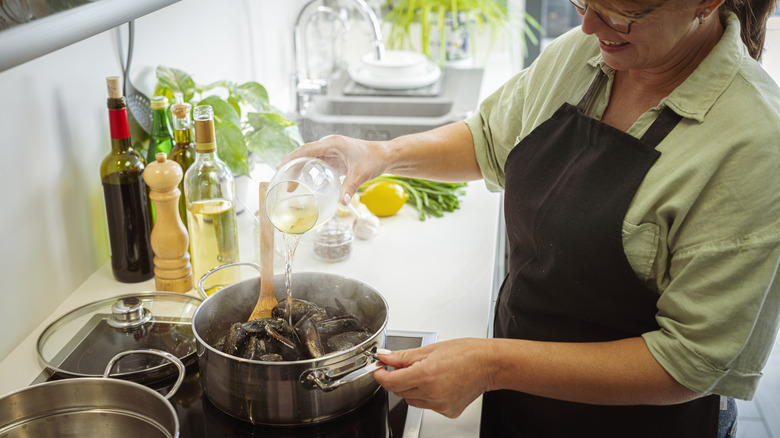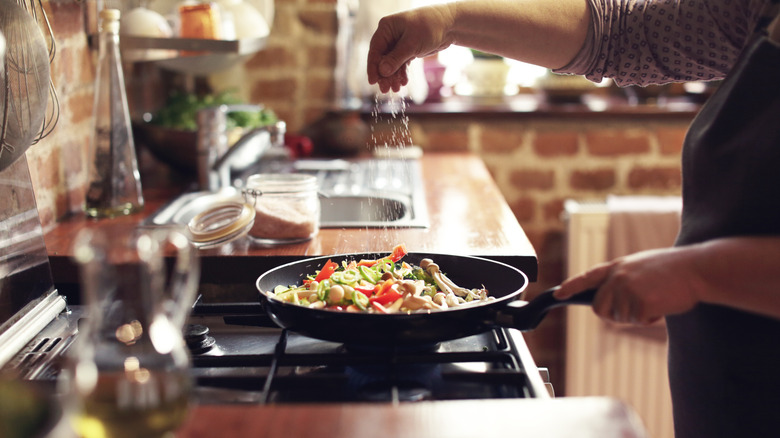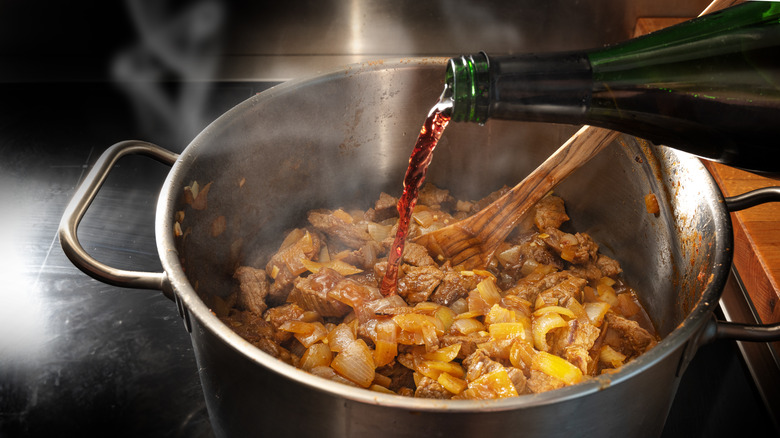Why Cooking Wine Is Salty, And How To Adjust For It
You won't find cooking wines next to the Champagne or Pinot Noir at your grocery store. They are stocked in the oils and vinegar section and for good reason. Cooking wines have a range of salt, sweeteners, and preservatives added to them to extend their shelf life. They are used as flavor enhancers, much like soy sauce or apple cider vinegar. By law, the additives are part of the reason they are classified as "salted wine" and not a beverage, so they are not taxed as alcohol.
In most cases, using regular table wine as your cooking wine is the way to go because it won't have salt content and heavy preservatives. But there are some cases where cooking wine does just fine. The key to using it is understanding the amount of salt you should adjust for. For starters, taste it. And by that, we don't mean by the glass. Cooking wine is not meant for sipping, rather it is used to add a depth of flavor to your dish — use a spoon for a little taste.
How to adjust your dish when using cooking wine
Dry red and white cooking wines typically have about 190 milligrams of sodium per serving size of 2 tablespoons. For a dish, you will want to underseason the salt and adjust by tasting after the cooking wine has been added and cooked through. Cooking wine also has a higher alcohol percentage (around 17%) than standard wine; because alcohol evaporates when simmered, this additional alcohol allows cooking wine to be cooked for a longer period.
Acidity is the main element added to the dish from cooking wine, along with a depth of flavor. Use red cooking wine for deeper dishes like hearty meat stews of boeuf bourguignon or roast proteins like coq au vin. White cooking wine can be used in creamy pasta, risotto, and lighter soups. Rice wine is used in many Asian dishes to add an umami flavor and light depth. Cooking sherry wine has a nutty and caramelized flavor and is used for, you guessed it, desserts. In all these preparations, read the label to see exactly how much sodium you are adding to the dish, and adjust your seasoning accordingly, leaving out a portion of the salt (or salty ingredients) until the cooking wine has been added and you've had a chance to taste your dish. Remember, you can always add more salt later if your recipe is tasting a bit bland.
Wine vs. cooking wine
You don't have to use cooking wine — regular wine does the trick just fine, and better. To decide what bottle to use, a good rule of thumb is to cook with the wine that you would serve your dish with. That does not mean you need to pour away your special bottle of Syrah into the pan. The trick is to match the flavors of the dish with an inexpensive table wine, and hey, maybe even have a chef's glass while you prep. The alcohol will dissipate as the dish cooks, and the flavors of the wine will integrate themselves beautifully into the food.
Cooking wine, on the other hand, is made primarily for shelf life. If you do not drink wine and simply need a couple of tablespoons for a recipe, it is better to use cooking wine instead of letting a whole bottle of wine go stale. Cooking wine is significantly more inexpensive than wine, too. The toss-up is dealing with the added salt, sugar, and preservatives.
If you'd rather not use either in a dish, you can substitute with stock, Worcestershire sauce, or balsamic vinegar in savory dishes, depending on what the recipe calls for. Whatever you choose, make sure to taste your dish as you cook. There's a reason chefs are always dunking their tasting spoons in simmering pots. It's the best way to determine if the dish is too salty or just right.


